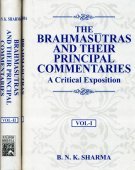Sushumnanadi, Suṣumnānāḍi, Sushumna-nadi: 2 definitions
Introduction:
Sushumnanadi means something in Hinduism, Sanskrit. If you want to know the exact meaning, history, etymology or English translation of this term then check out the descriptions on this page. Add your comment or reference to a book if you want to contribute to this summary article.
The Sanskrit term Suṣumnānāḍi can be transliterated into English as Susumnanadi or Sushumnanadi, using the IAST transliteration scheme (?).
In Hinduism
Shaivism (Shaiva philosophy)
Source: Brill: Śaivism and the Tantric TraditionsSuṣumnānāḍī (सुषुम्नानाडी) or simply Suṣumnā refers to the “central channel (of the yogic body)” resembling the vertical sequence of bodily lotuses connected by the Śaktisūtra or Śaktitantu (“cord of power”), according to the Brahmayāmala-tantra (or Picumata), an early 7th century Śaiva text consisting of twelve-thousand verses.—[The padmamālā-vidhi prescribes installing deities within series of nine, seven and eight lotuses].—The principal series of nine lotuses [i.e., Kapālīśabhairava, the four Devīs and the four Dūtīs] spans the body’s axis from crest (śikhā) to feet (pāda), linked by the śaktitantu and thus forming a vertical strand. This vertical sequence of bodily lotuses connected by a cord of śakti has obvious similarities with models of the yogic body in which suṣumnānāḍī, the central channel, links together an ascending series of cakras or lotuses. This ubiquitous paradigm is exemplified by the system of seven cakras common to Śrīvidyā and Haṭhayoga as being first attested in the Kubjikāmata.

Shaiva (शैव, śaiva) or Shaivism (śaivism) represents a tradition of Hinduism worshiping Shiva as the supreme being. Closely related to Shaktism, Shaiva literature includes a range of scriptures, including Tantras, while the root of this tradition may be traced back to the ancient Vedas.
Languages of India and abroad
Kannada-English dictionary
Source: Alar: Kannada-English corpusSuṣumnānāḍi (ಸುಷುಮ್ನಾನಾಡಿ):—[noun] = ಸುಷುಮ್ನೆ - [sushumne -] 1.
Kannada is a Dravidian language (as opposed to the Indo-European language family) mainly spoken in the southwestern region of India.
See also (Relevant definitions)
Partial matches: Sushumna, Nadi, Nati.
Query error!
Full-text: Shambhavi.
Relevant text
Search found 15 books and stories containing Sushumnanadi, Sushumna-nadi, Suṣumnā-nāḍi, Susumna-nadi, Suṣumnānāḍi, Susumnanadi; (plurals include: Sushumnanadis, nadis, nāḍis, Suṣumnānāḍis, Susumnanadis). You can also click to the full overview containing English textual excerpts. Below are direct links for the most relevant articles:
Cidgaganacandrika (study) (by S. Mahalakshmi)
Verse 123 [Khecarī attains Śambhupada through Suṣumnā-nāḍi] < [Chapter 3 - Third Vimarśa]
Yogashikha Upanishad (critical study) (by Sujatarani Giri)
Part 2.1e - Viśuddha cakra (The throat centre) < [Chapter 5 - Nature of Yoga practice in Upaniṣad]
Part 2.1c - Maṇipura cakra (The naval centre) < [Chapter 5 - Nature of Yoga practice in Upaniṣad]
Part 2.1d - Anāhata cakra (The heart centre) < [Chapter 5 - Nature of Yoga practice in Upaniṣad]
The concept of Yoga according to Yoga Upanisads (by Jeong Soo Lee)
1.5. The concept of Cakra (according to Yoga) < [Chapter 7 - Hatha, Laya, and Mantra Yoga in the Yogopanisads]
1.4. The concept of Nadi (according to Yoga) < [Chapter 7 - Hatha, Laya, and Mantra Yoga in the Yogopanisads]
2.3. The concept of Bandha (in Yoga) < [Chapter 7 - Hatha, Laya, and Mantra Yoga in the Yogopanisads]
Shaiva Upanishads (A Critical Study) (by Arpita Chakraborty)
1. Meditation on Praṇava < [Chapter 2 - “Om” and its Esoteric Significance]
Yogatattva Upanishad (translation and study) (by Sujata Jena)
Part 1.3 - Cakra Dharana < [Chapter 5 - Philosophy of Life and Meditation in Yogatattva Upanisad]
Part 2.4 - Branches of Yoga—Hathayoga < [Chapter 3 - Yoga Philosophy in Yogatattva Upanisad]
Part 1.1 - Types of Dharana (concentration of the mind)—Introduction < [Chapter 5 - Philosophy of Life and Meditation in Yogatattva Upanisad]
International Ayurvedic Medical Journal
Scope of fundamental research in rachana sharir < [2022, Issue 3, March]
Paths of yoga for different saadhaka < [2016, Issue IV April]
Anatomical elucidation of chakras < [2016, Issue III March]
Related products
